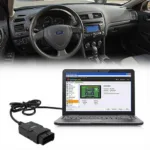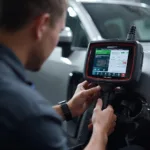The OBD2 code P1693 is a somewhat mysterious code that can cause confusion and frustration for car owners. This guide will delve into the meaning of the P1693 code, its common causes, symptoms, diagnostic procedures, and potential solutions. We’ll explore everything you need to know about this trouble code, empowering you to tackle the issue effectively.
What Does the OBD2 P1693 Code Mean?
The P1693 code refers to a “Fault in Comparator Circuit.” This rather generic description indicates a problem in the communication between two control modules in your vehicle. It’s often associated with the Powertrain Control Module (PCM) and other modules, such as the Transmission Control Module (TCM) or the Body Control Module (BCM). This communication breakdown can lead to various drivability issues and requires proper diagnosis to pinpoint the exact cause.
Common Causes of the OBD2 P1693 Code
The P1693 code can be triggered by several issues, ranging from simple wiring problems to more complex module failures. Here are some of the most common causes:
- Wiring Problems: Damaged, corroded, or loose wiring harnesses in the communication network can disrupt the signal flow between modules, resulting in the P1693 code.
- Faulty PCM: A malfunctioning PCM can be the root cause of the P1693 code. This could be due to internal damage or software glitches.
- Faulty TCM or BCM: Similar to the PCM, a faulty TCM or BCM can also trigger the P1693 code if it’s unable to communicate effectively with other modules.
- Low Battery Voltage: A weak or failing battery can cause voltage fluctuations, which can interfere with the communication network and trigger the P1693 code.
Symptoms of the OBD2 P1693 Code
The symptoms associated with the P1693 code can vary depending on the underlying cause and the specific vehicle. However, some common symptoms include:
- Check Engine Light: The illumination of the check engine light is the most obvious symptom.
- Transmission Problems: Shifting issues, such as harsh shifts or slipping, can occur.
- Reduced Fuel Economy: A decrease in fuel efficiency might be observed.
- Drivability Issues: Stalling, rough idling, or lack of power can also be symptoms.
- Other Warning Lights: Other warning lights, such as the ABS or traction control light, might also illuminate.
How to Diagnose and Fix the OBD2 P1693 Code
Diagnosing the P1693 code requires a systematic approach. Here’s a step-by-step guide:
- Retrieve the Code: Use an OBD2 scanner to retrieve the stored trouble codes.
- Inspect Wiring: Carefully check all wiring harnesses and connectors related to the communication network for damage, corrosion, or loose connections.
- Check Battery Voltage: Test the battery voltage to ensure it’s within the specified range.
- Test Modules: Use a diagnostic tool to test the PCM, TCM, and BCM for proper functioning.
- Seek Professional Help: If you’re unable to pinpoint the cause, consult a qualified mechanic for further diagnosis and repair.
Conclusion: Resolving the OBD2 P1693 Code
The OBD2 P1693 code can seem daunting, but with the right information and approach, you can effectively diagnose and resolve the issue. By understanding its meaning, common causes, symptoms, and diagnostic procedures, you can get your vehicle back on the road smoothly. Remember to always prioritize safety and consult a professional if needed.
FAQs
- What is the most common cause of the P1693 code? Wiring problems are often the most common culprit.
- Can I drive my car with the P1693 code? It’s advisable to address the issue promptly as it can lead to further problems.
- How much does it cost to fix the P1693 code? The cost varies depending on the underlying cause.
- Is the P1693 code serious? While not immediately dangerous, it can lead to more significant issues if left unresolved.
- Can I fix the P1693 code myself? If you have some mechanical skills, you might be able to address simple wiring issues, but more complex problems require professional help.
- What tools do I need to diagnose the P1693 code? An OBD2 scanner is essential.
- What should I do if the P1693 code returns after repair? Consult a mechanic to re-evaluate the diagnosis and repair.
Need help with your OBD2 P1693 code? Contact us via WhatsApp: +1(641)206-8880, Email: [email protected] or visit us at 789 Elm Street, San Francisco, CA 94102, USA. Our 24/7 customer support team is here to assist you.


